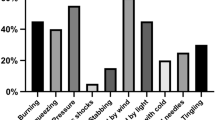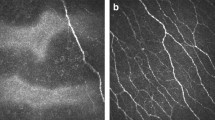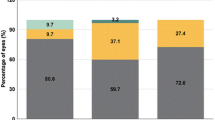Abstract
Purpose
The most likely etiology of post-LASIK dry eye is corneal nerve damage; however, no direct relationship between post-LASIK dry eye symptoms and nerve damage has been established, and limited information is available about the relationship between dry eye signs and corneal reinnervation after LASIK. Tear neuropeptides (SP and CGRP) are important in the maintenance of corneal nerve health, but the impact of LASIK has not yet been studied. This study evaluated changes in nerve morphology, tear neuropeptide, and dry eye, so as to establish the relationship between reinnervation and dry eye and to assess the role of tear neuropeptides in reinnervation post-LASIK.
Methods
Twenty non-dry eye volunteers who had undergone bilateral myopic-LASIK completed this study. Corneal nerve morphology (density, width, interconnections, and tortuosity), SP and CGRP concentration, and dry eye were monitored over time prior to, 1 day, 1 week, 1, 3, and 6 months post-LASIK.
Results
Dry eye symptoms and tear function, except for osmolarity (P = 0.003), remained unchanged post-LASIK. Corneal nerve morphology decreased immediately, and did not return to preoperative levels by 6 months post-LASIK (P < 0.001). Increased tear SP concentration was observed 3 months post-LASIK (P < 0.001). Associations between reinnervation as measured by increased density and lower tear SP (P = 0.03), and between increased density and decreased dry eye symptoms (P = 0.01) were found post-LASIK.
Conclusion
An inverse relationship between reinnervation post-LASIK and dry eye symptoms was found, confirming that post-LASIK dry eye is a neuropathic disease. This study is the first to demonstrate an association between tear SP and post-LASIK reinnervation, suggesting that strategies for manipulating neuropeptide concentration to improve reinnervation may improve ocular comfort post-LASIK.





Similar content being viewed by others
References
Savini G, Barboni P, Zanini M, Tseng SC (2004) Ocular surface changes in laser in situ keratomileusis-induced neurotrophic epitheliopathy. J Refract Surg 20:803–809
Wilson SE (2001) Laser in situ keratomileusis-induced (presumed) neurotrophic epitheliopathy. Ophthalmology 108:1082–1087
Wilson SE, Ambrosio R (2001) Laser in situ keratomileusis-induced neurotrophic epitheliopathy. Am J Ophthalmol 132:405–406
Stern ME, Beuerman RW, Fox RI, Gao J, Mircheff AK et al (1998) The pathology of dry eye: the interaction between the ocular surface and lacrimal glands. Cornea 17:584–589
Quinto GG, Camacho W, Behrens A (2008) Postrefractive surgery dry eye. Curr Opin Ophthalmol 19:335–341
Calvillo MP, McLaren JW, Hodge DO, Bourne WM (2004) Corneal reinnervation after LASIK: prospective 3-year longitudinal study. Invest Ophthalmol Vis Sci 45:3991–3996
Erie JC, McLaren JW, Hodge DO, Bourne WM (2005) Recovery of corneal subbasal nerve density after PRK and LASIK. Am J Ophthalmol 140:1059–1064
Darwish T, Brahma A, O’Donnell C, Efron N (2007) Subbasal nerve fiber regeneration after LASIK and LASEK assessed by noncontact esthesiometry and in vivo confocal microscopy: prospective study. J Cataract Refract Surg 33:1515–1521
Chao C, Golebiowski B, Stapleton F (2014) The role of corneal innervation in LASIK-induced neuropathic dry eye. Ocul Surf 12:32–45
Garcia-Hirschfeld J, Lopez-Briones LG, Belmonte C (1994) Neurotrophic influences on corneal epithelial cells. Exp Eye Res 59:597–605
De Felipe C, Gonzalez GG, Gallar J, Belmonte C (1999) Quantification and immunocytochemical characteristics of trigeminal ganglion neurons projecting to the cornea: effect of corneal wounding. Eur J Pain 3:31–39
Belmonte C, Acosta MC, Gallar J (2004) Neural basis of sensation in intact and injured corneas. Exp Eye Res 78:513–525
De Felipe C, Herrero JF, O’Brien JA, Palmer JA, Doyle CA et al (1998) Altered nociception, analgesia and aggression in mice lacking the receptor for substance P. Nature 392:394–397
Chen LJ, Zhang FG, Li J, Song HX, Zhou LB et al (2010) Expression of calcitonin gene-related peptide in anterior and posterior horns of the spinal cord after brachial plexus injury. J Clin Neurosci 17:87–91
Mikulec AA, Tanelian DL (1996) CGRP increases the rate of corneal re-epithelialization in an in vitro whole mount preparation. J Ocul Pharmacol Ther 12:417–423
Troger J, Kieselbach G, Teuchner B, Kralinger M, Nguyen QA et al (2007) Peptidergic nerves in the eye, their source and potential pathophysiological relevance. Brain Res Rev 53:39–62
Papp A, Valtonen P (2006) Tissue substance P levels in acute experimental burns. Burns 32:842–845
Mertaniemi P, Ylätupa S, Partanen P, Tervo T (1995) Increased release of immunoreactive calcitonin gene-related peptide (CGRP) in tears after laser keratectomy. Exp Eye Res 60:659–665
Lee HK, Lee KS, Kim HC, Lee SH, Kim EK (2005) Nerve growth factor conentration and implications in photorefractive keratectomy vs laser in situ keratomileusis. Am J Ophthalmol 139:965–971
Albietz JM, Lenton LM (2004) Management of the ocular surface and tear film before, during, and after laser in situ keratomileusis. J Refract Surg 20:62–71
Dooley I, D’Arcy F, O’Keefe M (2012) Comparison of dry-eye disease severity after laser in situ keratomileusis and laser-assisted subepithelial keratectomy. J Cataract Refract Surg 38:1058–1064
Mian SI, Li AY, Dutta S, Musch DC, Shtein RM (2009) Dry eyes and corneal sensation after laser in situ keratomileusis with femtosecond laser flap creation effect of hinge position, hinge angle, and flap thickness. J Cataract Refract Surg 35:2092–2098
Mian SI, Shtein RM, Nelson A, Musch DC (2007) Effect of hinge position on corneal sensation and dry eye after laser in situ keratomileusis using a femtosecond laser. J Cataract Refract Surg 33:1190–1194
Sun CC, Chang CK, Ma DH, Lin YF, Chen KJ et al (2013) Dry eye after LASIK with a femtosecond laser or a mechanical microkeratome. Optom Vis Sci 90:1048–1056
Vroman DT, Sandoval HP, Fernandez de Castro LE, Kasper TJ, Holzer MP et al (2005) Effect of hinge location on corneal sensation and dry eye after laser in situ keratomileusis for myopia. J Cataract Refract Surg 31:1881–1887
Donnenfeld ED, Ehrenhaus M, Solomon R, Mazurek J, Rozell JC et al (2004) Effect of hinge width on corneal sensation and dry eye after laser in situ keratomileusis. J Cataract Refract Surg 30:790–797
Donnenfeld ED, Solomon K, Perry HD, Doshi SJ, Ehrenhaus M et al (2003) The effect of hinge position on corneal sensation and dry eye after LASIK. Ophthalmology 110:1023–1029
Nejima R, Miyata K, Tanabe T, Okamoto F, Hiraoka T et al (2005) Corneal barrier function, tear film stability, and corneal sensation after photorefractive keratectomy and laser in situ keratomileusis. Am J Ophthalmol 139:64–71
Toda I, Asano-Kato N, Komai-Hori Y, Tsubota K (2001) Dry eye after laser in situ keratomileusis. Am J Ophthalmol 132:1–7
Yu EY, Leung A, Rao S, Lam DS (2000) Effect of laser in situ keratomileusis on tear stability. Ophthalmology 107:2131–2135
Albietz JM, Lenton LM, McLennan SG (2002) Effect of laser in situ keratomileusis for hyperopia on tear film and ocular surface. J Refract Surg 18:113–123
Patel S, Alio JL, Artola A, Martinez MJ (2007) Tear volume and stability after LASIK. J Refract Surg 23:290–298
Tao A, Shen M, Wang J, Chen Q, Lu F (2010) Upper and lower tear menisci after laser in situ keratomileusis. Eye Contact Lens 36:81–85
Albietz JM, Lenton LM, McLennan SG (2005) Dry eye after LASIK: comparison of outcomes for Asian and Caucasian eyes. Clin Exp Optom 88:89–96
Lee S, Kim J, Seo K, Kim EK, Lee HK (2006) Comparison of corneal nerve regeneration and sensitivity between LASIK and laser epithelial keratomileusis (LASEK). Am J Ophthalmol 141:1009–1015
Stapleton F, Hayward KB, Bachand N, Trong PH, Teh DW et al (2006) Evaluation of corneal sensitivity to mechanical and chemical stimuli after LASIK: a pilot study. Eye Contact Lens 32:88–93
Lee JB, Ryu CH, Kim J, Kim EK, Kim HB (2000) Comparison of tear secretion and tear film instability after photorefractive keratectomy and laser in situ keratomileusis. J Cataract Refract Surg 26:1326–1331
Johnson ME, Murphy PJ (2007) Measurement of ocular surface irritation on a linear interval scale with the Ocular Comfort Index. Invest Ophthalmol Vis Sci 48:4451–4458
Chao C, Golebiowski B, Cui Y, Stapleton F (2014) Development of a Chinese version of the Ocular Comfort Index. Invest Ophthalmol Vis Sci 55:3562–3571
Gokhale M, Stahl U, Jalbert I (2013) In situ osmometry: validation and effect of sample collection technique. Optom Vis Sci 90:359–365
Versura P, Profazio V, Campos EC (2010) Performance of tear osmolarity compared to previous diagnostic tests for dry eye diseases. Curr Eye Res 35:553–564
Chen F, Shen M, Chen W, Wang J, Li M et al (2010) Tear meniscus volume in dry eye after punctal occlusion. Invest Ophthalmol Vis Sci 51:1965–1969
Li J, Shen M, Wang J, Ma H, Tao A et al (2012) Clinical significance of tear menisci in dry eye. Eye Contact Lens 38:183–187
Guillon M, Styles E, Guillon JP, Maissa C (1997) Preocular tear film characteristics of nonwearers and soft contact lens wearers. Optom Vis Sci 74:273–279
Lemp MA, Bron AJ, Baudouin C, Benítez Del Castillo JM, Geffen D et al (2011) Tear osmolarity in the diagnosis and management of dry eye disease. Am J Ophthalmol 151:792–798
Jones SM, Nischal KK (2013) The non-invasive tear film break-up time in normal children. Br J Ophthalmol 97:1129–1133
Nichols JJ, Nichols KK, Puent B, Saracino M, Mitchell GL (2002) Evaluation of tear film interference patterns and measures of tear break-up time. Optom Vis Sci 79:363–369
Shen M, Wang J, Tao A, Chen Q, Lin S, Qu J, Lu F (2008) Diurnal variation of upper and lower tear menisci. Am J Ophthalmol 145:801–806
Jalbert I, Chao C, Stapleton F, Ashby B, Golebiowski B (2012) Associations between corneal nerve density, corneal sensitivity, and tear substance P in lens wearers. Optom Vis Sci 89:E-abstract 120722
Golebiowski B, Papas E, Stapleton F (2011) Assessing the sensory function of the ocular surface: implications of use of a non-contact air jet aesthesiometer versus the Cochet–Bonnet aesthesiometer. Exp Eye Res 92:408–413
Cochet P, Bonnet R (1960) L’esthésie cornéenne. Clin Ophthalmol 4:3–27
Chao C, Stapleton F, Badarudin E, Golebiowski B (2015) Ocular surface sensitivity repeatability with Cochet–Bonnet esthesiometer. Optom Vis Sci 92:182–189
Lum E (2014) The impact of overnight orthokeratology on sub-basal nerve plexus morphology and corneal sensitivity. Dissertation, The University of New South Wales
Lum E, Golebiowski B, Swarbrick HA (2012) Mapping the corneal sub-basal nerve plexus in orthokeratology lens wear using in vivo laser scanning confocal microscopy. Invest Ophthalmol Vis Sci 53:1803–1809
Meijering E, Jacob M, Sarria JC, Steiner P, Hirling H et al (2004) Design and validation of a tool for neurite tracing and analysis in fluorescence microscopy images. Cytometry A 58:167–176
Oliveira-Soto L, Efron N (2001) Morphology of corneal nerves using confocal microscopy. Cornea 20:374–384
Yaksh TL, Dirig DM, Conway CM, Svensson C, Luo ZD et al (2001) The acute antihyperalgesic action of nonsteroidal, anti-inflammatory drugs and release of spinal prostaglandin E2 is mediated by the inhibition of constitutive spinal cyclooxygenase-2 (COX-2) but not COX-1. J Neurosci 21:5847–5853
Staton PC, Wilson AW, Bountra C, Chessell IP, Day NC (2007) Changes in dorsal root ganglion CGRP expression in a chronic inflammatory model of the rat knee joint: differential modulation by rofecoxib and paracetamol. Eur J Pain 11:283–289
Nohr D, Schafer MK, Persson S, Romeo H, Nyberg F et al (1999) Calcitonin gene-related peptide gene expression in collagen-induced arthritis is differentially regulated in primary afferents and motoneurons: influence of glucocorticoids. Neuroscience 93:759–773
Wong HK, Tan KJ (2002) Effects of corticosteroids on nerve root recovery after spinal nerve root compression. Clin Orthop Relat Res 403:248–252
Han SH, An HJ, Song JY, Shin DE, Kwon YD et al (2012) Effects of corticosteroid on the expressions of neuropeptide and cytokine mRNA and on tenocyte viability in lateral epicondylitis. J Inflamm 9:40
Patel SV, McLaren JW, Kittleson KM, Bourne WM (2010) Subbasal nerve density and corneal sensitivity after laser in situ keratomileusis: femtosecond laser vs mechanical microkeratome. Arch Ophthalmol 128:1413–1419
Moilanen JA, Holopainen JM, Vesaluoma MH, Tervo TM (2008) Corneal recovery after lasik for high myopia: a 2-year prospective confocal microscopic study. Br J Ophthalmol 92:1397–1402
Lee BH, McLaren JW, Erie JC, Hodge DO, Bourne WM (2002) Reinnervation in the cornea after LASIK. Invest Ophthalmol Vis Sci 43:3660–3664
Linna TU, Vesaluoma MH, Perez-Santonja JJ, Petroll WM, Alio JL et al (2000) Effect of myopic LASIK on corneal sensitivity and morphology of subbasal nerves. Invest Ophthalmol Vis Sci 41:393–397
Linna TU, Perez-Santonja JJ, Tervo KM, Sakla HF, Alio y Sanz JL et al (1998) Recovery of corneal nerve morphology following laser in situ keratomileusis. Exp Eye Res 66:755–763
Patel DV (2005) In vivo confocal microscopy of the cornea in health and disease. Dissertation, University of Auckland
Labbe A, Alalwani H, Van Went C, Brasnu E, Georgescu D et al (2012) The relationship between subbasal nerve morphology and corneal sensation in ocular surface disease. Invest Ophthalmol Vis Sci 53:4926–4931
Labbe A, Liang Q, Wang Z, Zhang Y, Xu L et al (2013) Corneal nerve structure and function in patients with non-Sjögren dry eye: clinical correlations. Invest Ophthalmol Vis Sci 54:5144–5150
Zhang M, Chen J, Luo L, Xiao Q, Sun M et al (2005) Altered corneal nerves in aqueous tear deficiency viewed by in vivo confocal microscopy. Cornea 24:818–824
Albietz JM, McLennan SG, Lenton LM (2003) Ocular surface management of photorefractive keratectomy and laser in situ keratomileusis. J Refract Surg 19:636–644
Patel DV, Ku JY, Johnson R, McGhee CN (2009) Laser scanning in vivo confocal microscopy and quantitative aesthesiometry reveal decreased corneal innervation and sensation in keratoconus. Eye (Lond) 23:586–592
Patel DV, Tavakoli M, Craig JP, Efron N, McGhee CN (2009) Corneal sensitivity and slit scanning in vivo confocal microscopy of the subbasal nerve plexus of the normal central and peripheral human cornea. Cornea 28:735–740
Patel SV, McLaren JW, Hodge DO, Bourne WM (2002) Confocal microscopy in vivo in corneas of long-term contact lens wearers. Invest Ophthalmol Vis Sci 43:995–1003
Acknowledgments
Support for the tear osmolarity testcards by TearLab Corporation is acknowledged. The authors thank Dr Wei Chen for the instrument support (TearLab) in China. We would like to thank staff in the refractive surgery outpatient unit in Wenzhou Eye Hospital for assistance with data collection, and are grateful for the lab support from Zhou’s team in the School of Ophthalmology and Optometry, Wenzhou Medical University. In addition, we would like to thank Dr Ren Chen for his kind contribution.
Conflict of interest disclosures
All authors certify that they have NO affiliations with or involvement in any organization or entity with any financial interest (such as honoraria; educational grants; participation in speakers’ bureaus; membership, employment, consultancies, stock ownership, or other equity interest; and expert testimony or patent-licensing arrangements), or non-financial interest (such as personal or professional relationships, affiliations, knowledge, or beliefs) in the subject matter or materials discussed in this manuscript.
Financial support
This study was supported by the University of New South Wales and Wenzhou Medical University. CC received a scholarship from the Australian Government through the International Postgraduate Research Scholarship scheme. SZ received a scholarship from Government Supported Student Award from China. SH received grant supports from Key Technological Innovation Team, Wenzhou China (Refractive surgery new technologies and new product, C20120009-02) and National Key Technology Research and Development Program of the Ministry of Science and Technology of China (2012BAI08B05). The sponsor or funding organization had no role in the design or conduct of this research.
Author information
Authors and Affiliations
Corresponding author
Rights and permissions
About this article
Cite this article
Chao, C., Stapleton, F., Zhou, X. et al. Structural and functional changes in corneal innervation after laser in situ keratomileusis and their relationship with dry eye. Graefes Arch Clin Exp Ophthalmol 253, 2029–2039 (2015). https://doi.org/10.1007/s00417-015-3120-1
Received:
Revised:
Accepted:
Published:
Issue Date:
DOI: https://doi.org/10.1007/s00417-015-3120-1




